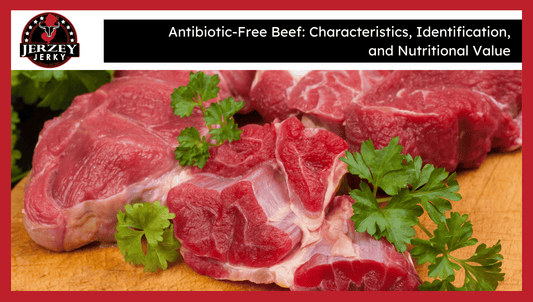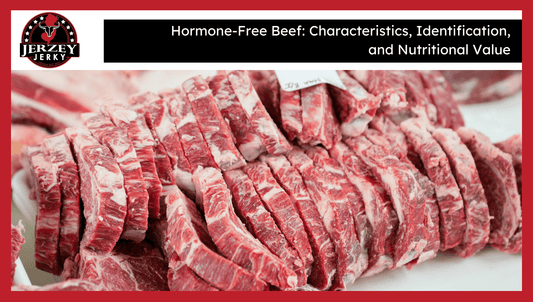
Jerky: Definition, Types & Flavors
Jerky is a nutrient-rich dried meat snack marinated in seasonings and sliced into thin strips. It is protein-packed and low in calories. Jerky can be easily stored at room temperature without refrigeration.
The ancient Inca and Aztec civilizations used this technique to preserve meat. The term “jerky” comes from a Spanish word, “charque,” which means “dry salted meat.”
According to a Kansas State University research, from the College of Agriculture, published in 2024, the consumption of beef jerky increased by 1.4% from 2020 to 2022. The Global News Wire estimated that the annual jerky sales increased from $5.95 billion in 2024 to $6.34 billion in 2025.

How is Jerky Made?
Jerky is typically made by thawing frozen meat, slicing it, marinating it with spices, and then drying or smoking it. The heating and drying steps are sometimes combined.
According to a research by the Ohio State University, from the department of Family and Consumer Sciences, published on 8th February, 2017, jerky preparation involves the following steps:
Jerky can be prepared in the U.S. from various meat sources, including chicken, beef, turkey, elk, pork, and other game animals. The meat selection contains less than 10% fat, as fattier meat can become rancid quickly. Select the ground meat, 93% lean or higher.
Meat Preparation:
Meat preparation includes partially freezing the meat so that it becomes easier to slice. Then trim the visible fat and connective tissue from the meat. Slice the meat into thin, long strips—around ¼ inch thick and 1 to 1½ inches wide. Slice the meat perpendicular to the grain to have tender and chewy jerky.
Marination:
Put the sliced meat in a flat bottomed utensil and marinate it. Refrigerate it for at least 60 to 120 minutes or for 24 hours for enhanced flavor. Take 1 pound of lean meat and marinate it using these ingredients:
-
¼ cup soy sauce
-
1 tablespoon Worcestershire sauce
-
¼ teaspoon garlic powder
-
½ teaspoon onion powder
-
¼ teaspoon pepper
-
1 teaspoon hickory smoke flavored salt
Heat the marinated meat to 160°F or boil for 5 minutes, then drain it and dry. It helps get rid of microorganisms present in the raw meat.
Drying:
Dry the jerky in an oven or electric dehydrator.
-
Oven Drying: Place the meat at least 4 inches away from the heat source and set the oven temperature at 145°F to 170°F. Keep the door slightly unclosed to facilitate the air flow and place a fan nearby.
-
Electric Dehydrator: Set the dehydrator’s thermostat at its highest setting–around 180oF to 200oF.
Place the meat strips on the paper towel to remove excess moisture. Grease the tray with oil to keep the jerky from sticking. Transfer the meat slices to the tray, arranging them close to each other. Leave 25% open space on each tray to allow air flow. Rotate the trays every two hours for the best results.
Test for Doneness:
Test for doneness after cooling! The jerky slightly cracks but does not break upon bending if it’s done.
Storage:
Press the jerky between clean paper towels to absorb any excess fat once it is done. Cool it to room temperature and package in air-tight containers. Jerky has a shelf life of 14 days at 20oC and up to six weeks at 4oC.
What are the Types of Jerky?
There are 7 main types of jerky, including:
-
Beef Jerky
-
Turkey Jerky
-
Chicken Jerky
-
Pork Jerky
-
Fish Jerky
-
Game Jerky
-
Plant Based Jerky
Beef Jerky
Beef jerky is prepared from the cuts of beef, typically from leaner parts like flank or brisket. Heme iron present in beef jerky helps treat iron deficiency. It helps boost immunity and build muscle mass. However, beef jerky has high sodium levels.
Turkey Jerky
Turkey jerky is prepared from smoked turkey meat. It gets digested easily as it is leaner and highly satiating. It also promotes muscle growth just like beef jerky.
Chicken Jerky
Chicken jerky is a lean, high-protein snack for muscle repair. It allows portion control, ensures satiety, and supports your weight loss journey. It is a gluten-free option.
Pork Jerky
It is a beef jerky alternative containing vitamins and minerals that help improve metabolism and stay active. It also boosts immunity.
Fish Jerky
Fish jerky is a preserved seafood product prepared from fish like salmon or tuna. It is packed in proteins and heart healthy omega 3s.
Here are two types of fish jerky:
1- Salmon Jerky
2- Tuna Jerky
Salmon Jerky
Salmon jerky is made from salmon fillets. It is rich in vitamins and minerals. It also helps lower blood cholesterol levels. Salmon meat promotes heart health and improves insulin sensitivity. Salmon jerky contains zero saturated fats.
Tuna Jerky
Tuna jerky is prepared from sushi-grade ahi tuna. Just like salmon jerky, it also contains a good amount of antioxidants like vitamin C, zinc, and manganese. It helps boost immunity and reduce blood pressure levels. It also supports eye health by preventing macular degeneration.
Game Jerky
Game jerky is a dried snack prepared from game (wild animals) such as goose, wild boar, moose, and duck meat. Wild game is leaner and cleaner than farmed meats as it is not exposed to antibiotics or any other pharmaceuticals. It is a nutritional powerhouse.
Here are three main types of game jerky:
1- Venison Jerky
2- Bison Jerky
3- Elk Jerky
Venison Jerky
It is prepared from dried deer meat, having high omega-3s ratio and vitamin B levels. These nutrients help boost metabolism and play a part in regulating hormones. It is also free from pharmaceuticals and hormones.
Bison Jerky
It is a beef jerky alternative made from buffalo meat. Bison meat is leaner and has a healthier fatty acid profile than beef jerky. The omega 3 polyunsaturated fatty acids and selenium present in bison meat help lower inflammation and the risk of certain cancers.
Elk Jerky
It is a lean, dense protein and a chewy snack. Elk is also rich in omega-3s and fatty acids that help promote heart health and combat anxiety and depression. It is cholesterol free and rich in iron.
Plant-Based Jerky
Plant-based jerky is prepared from vegan ingredients like wheat gluten, pea protein, and soy. It contains a smaller amount of cholesterol than meat-based jerky. Plant-based protein reduces the risk of CVD and type 2 diabetes.
Here are the three main types of plant-based jerky:
1- Mushroom Jerky
2- Jackfruit Jerky
3- Soy Jerky
Mushroom Jerky
Mushroom jerky can be prepared from different types of mushrooms, including Shiitake, Portobello, King oyster, and white button. It serves as an alternative for meat.
Jackfruit Jerky
Jackfruit jerky is prepared from young, unripe jackfruit. The antioxidants and anti-inflammatory compounds present in the jackfruit lessen the chances of chronic diseases like hypertension, arthritis, and type 2 diabetes.
Soy Jerky
Soy jerky is prepared from soy protein products. It is a cholesterol-free snack that does not contain harmful cancerous compounds, such as heterocyclic amines and polycyclic aromatic hydrocarbons.
What are the Popular Jerky Flavors and Seasonings?
Jerky’s tender muscle fibers easily soak up flavors and make a fantastic base for countless marinades and seasonings.
Here are some popular jerky flavors and seasonings.
-
Classic & Traditional
-
Smoked
-
Spicy
-
Savory and Herbal
-
International and Fusion
-
Unique and Gourmet Blends
Classic & Traditional
Classic and traditional jerky flavors include original salt and pepper, peppered, and teriyaki. Peppered jerky is covered in coarse, cracked black pepper seasoning. Teriyaki jerky is marinated in sweet soy-based sauce, ginger, and garlic.
Smoked (Smoky Flavor from Wood Smoking)
Smoked jerky varieties come in sweet, honey-glazed, maple, and brown sugar flavors. Sweet and spicy jerky is prepared by adding honey and chilli flakes to the marinade.
Woods commonly used include:
-
Hickory (gives traditional smoky flavor)
-
Applewood (known for its fruity flavor)
-
Mesquite (offers intense earthiness)
-
Cherrywood (has a mild fruity profile)
Spicy Varieties
Spicy jerky flavors include sriracha, Jalapeno, Habanero, Cayenne pepper, and chipotle. They are prepared by marinating meat strips in hot peppers, spices and dried.
Savory and Herbal
These are prepared by adding a variety of herbs such as cilantro, rosemary, and thyme to the marinade. Herbal flavors range from garlic and herb, rosemary and thyme, cilantro lime, barbecue, and smoky mesquite.
International and Fusion Flavors
Fusion flavors include curry spiced, whiskey-infused, sweet peppercorn, and Korean BBQ dipped in soy, garlic, and ginger, and topped with sesame. Mexican Carne Asada jerky is enriched with Carne Asada flavors.
Unique and Gourmet Blends
Jerky seasoning gourmet blends range from maple bourbon to sweet pepper, and black cherry or berry infused flavors. The Asian five spice flavor is marinated in five spices. Sweet heat flavor, having a blend of sweetness with chilli heat, will tantalize your taste buds.

 2025-06-22
2025-06-22
 Wayne Holland
Wayne Holland










